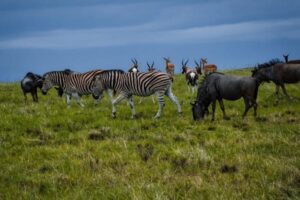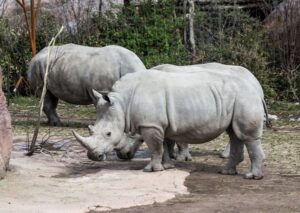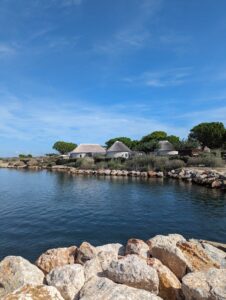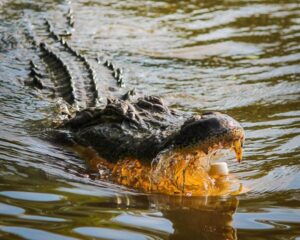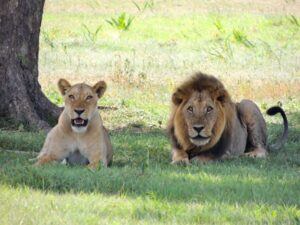The Masai Mara, an iconic wildlife reserve in Kenya, is renowned for its stunning landscapes, rich biodiversity, and the fascinating culture of the Maasai people. This reserve, named after the indigenous Maasai tribe and the Mara River that runs through it, offers a unique blend of natural beauty and cultural heritage. Here are some interesting facts about the Masai Mara that highlight its significance and allure:
Location and Size of Masai Mara
The Maasai Mara National Reserve is situated in southwestern Kenya, bordering Tanzania’s Serengeti National Park. It covers approximately 1,510 square kilometers (580 square miles). This expanse of savanna is characterized by rolling grasslands, acacia trees, and the Mara River, which provides a vital water source for the wildlife.
Great Migration of Masai Mara
One of the most spectacular wildlife events on the planet, the Great Migration, occurs annually in the Masai Mara. Over 1.5 million wildebeest, accompanied by hundreds of thousands of zebras and gazelles, migrate from the Serengeti in Tanzania to the Masai Mara in search of greener pastures. This journey is fraught with danger as they face predators like lions, cheetahs, and crocodiles. The dramatic river crossings, especially at the Mara River, are a highlight for tourists and wildlife enthusiasts.
Rich Biodiversity of Masai Mara
The Maasai Mara boasts an incredible diversity of wildlife. It is home to the “Big Five” – lions, leopards, elephants, buffaloes, and rhinos. Additionally, the reserve hosts numerous other species, including cheetahs, hippos, giraffes, and various antelope species. Birdwatchers can enjoy spotting over 450 bird species, ranging from large ostriches to colorful kingfishers and majestic eagles.
Conservation Efforts of Masai Mara
Efforts to preserve the Masai Mara‘s unique ecosystem are ongoing. The Masai community plays a significant role in conservation, balancing their traditional lifestyle with modern conservation techniques. Various organizations work to protect endangered species, combat poaching, and promote sustainable tourism practices that benefit both the wildlife and local communities.
Cultural Heritage of the Masai People of Masai Mara
The Masai people are integral to the identity of the Masai Mara. Known for their distinct customs, dress, and semi-nomadic lifestyle, the Masai have coexisted with wildlife for centuries. Visitors to the Masai Mara can experience Masai culture through village visits, where they can learn about traditional practices, participate in dances, and purchase handcrafted items like beaded jewelry and intricate carvings.
Historical Significance
The Masai Mara has a rich history that intertwines with the Masai people’s narratives. The Masai have lived in this region for hundreds of years, migrating with their cattle and living in harmony with nature. Their oral traditions, rituals, and ceremonies are passed down through generations, preserving their cultural heritage.
Ecotourism and Lodging of Masai Mara
The Masai Mara offers a variety of lodging options, from luxury tented camps to eco-friendly lodges. Ecotourism is a growing trend in the reserve, with many establishments adopting sustainable practices to minimize their environmental footprint. These lodgings often provide guided safaris, walking tours, and cultural experiences, ensuring that visitors gain a deep appreciation for the natural and cultural richness of the area.
Photographic Safaris
The Maasai Mara is a paradise for photographers. Offering unparalleled opportunities to capture wildlife in their natural habitat. The reserve’s open landscapes and abundant wildlife make it an ideal location for both amateur and professional photographers. Many lodges and tour operators offer specialized photographic safaris, providing expert guides and tips for capturing stunning images.
The Mara River
The Mara River is a lifeline for the ecosystem within the Masai Mara. It supports a variety of aquatic and terrestrial life forms. The river is most famous for the dramatic crossings during the Great Migration, where thousands of wildebeest and zebras brave the crocodile-infested waters, creating a breathtaking natural spectacle.
Role in Scientific Research
The Maasai Mara is an important site for scientific research and wildlife studies. Researchers from around the world come to study the behavior, genetics, and ecology of various species. These studies contribute valuable knowledge for conservation efforts and help in understanding the complex interactions within the ecosystem.
Climate and Weather
The Maasai Mara experiences a mild and temperate climate, making it a year-round destination. The rainy seasons occur from April to May and November to December, while the dry seasons are from June to October and January to March. Each season offers different experiences, from lush green landscapes and abundant wildlife during the rains to easier wildlife spotting during the dry months when animals gather around water sources.
Unique Flora of Masai Mara
The reserve’s vegetation is primarily savanna, dotted with acacia trees, bushes, and grasslands. The flora varies with the seasons, providing food and shelter for the diverse wildlife. The acacia trees are particularly notable, as they serve as vital resources for many herbivores and birds.
Night Safaris
For those looking to experience the Maasai Mara from a different perspective, night safaris are an option. These safaris offer a chance to see nocturnal animals such as leopards, hyenas, and various small predators. The night sky in the Maasai Mara is also a spectacle, with minimal light pollution providing a clear view of the stars.
Community Conservancies
In addition to the main reserve, there are several community conservancies surrounding the Maasai Mara. These conservancies are owned and managed by local Maasai communities and play a crucial role in wildlife conservation and sustainable tourism. They offer additional safari experiences and often have fewer tourists, providing a more intimate and exclusive experience.
Educational Programs of Masai Mara
Various educational programs in the Maasai Mara aim to raise awareness about conservation and the importance of protecting wildlife. These programs target both local communities and international visitors, fostering a greater understanding of the delicate balance within the ecosystem and the role each person can play in its preservation.
Economic Impact of Masai Mara
Tourism in the Maasai Mara significantly contributes to Kenya’s economy. It provides employment opportunities for local communities, supports businesses, and generates revenue that can be reinvested in conservation and community development projects. The sustainable management of tourism resources is crucial to maintaining the reserve’s long-term viability.
Iconic Safari Destination
The Maasai Mara is often featured in documentaries, films, and travel shows, solidifying its status as one of the world’s premier safari destinations. Its breathtaking scenery and unparalleled wildlife experiences attract thousands of visitors each year, making it a must-visit location for nature enthusiasts and adventure seekers.
Research and Conservation Partnerships
The Maasai Mara benefits from numerous partnerships between local and international conservation organizations. These collaborations support research, fund conservation projects, and promote the sustainable management of the reserve. Examples include partnerships with the Kenya Wildlife Service, WWF, and various universities and research institutions.
Future Prospects
The future of the Maasai Mara depends on the continued commitment to conservation and sustainable tourism. Balancing the needs of wildlife, local communities, and tourism development will be key to preserving this unique and invaluable ecosystem for future generations to enjoy.
Conclusion
The Maasai Mara is a remarkable blend of natural wonder and cultural heritage. Its rich biodiversity, dramatic wildlife migrations, and the enduring traditions of the Maasai people make it a unique and fascinating destination. While it faces challenges, ongoing conservation efforts and sustainable tourism practices provide hope for preserving this iconic reserve. Whether through witnessing the Great Migration, engaging with Maasai culture, or simply enjoying the breathtaking landscapes, a visit to the Maasai Mara is an unforgettable experience that highlights the beauty and complexity of the natural world.


